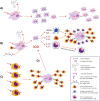Shifting the paradigm: engaging multicellular networks for cancer therapy
- PMID: 38475820
- PMCID: PMC10936124
- DOI: 10.1186/s12967-024-05043-8
Shifting the paradigm: engaging multicellular networks for cancer therapy
Abstract
Most anti-cancer modalities are designed to directly kill cancer cells deploying mechanisms of action (MOAs) centered on the presence of a precise target on cancer cells. The efficacy of these approaches is limited because the rapidly evolving genetics of neoplasia swiftly circumvents the MOA generating therapy-resistant cancer cell clones. Other modalities engage endogenous anti-cancer mechanisms by activating the multi-cellular network (MCN) surrounding neoplastic cells in the tumor microenvironment (TME). These modalities hold a better chance of success because they activate numerous types of immune effector cells that deploy distinct cytotoxic MOAs. This in turn decreases the chance of developing treatment-resistance. Engagement of the MCN can be attained through activation of immune effector cells that in turn kill cancer cells or when direct cancer killing is complemented by the production of proinflammatory factors that secondarily recruit and activate immune effector cells. For instance, adoptive cell therapy (ACT) supplements cancer cell killing with the release of homeostatic and pro-inflammatory cytokines by the immune cells and damage associated molecular patterns (DAMPs) by dying cancer cells. The latter phenomenon, referred to as immunogenic cell death (ICD), results in an exponential escalation of anti-cancer MOAs at the tumor site. Other approaches can also induce exponential cancer killing by engaging the MCN of the TME through the release of DAMPs and additional pro-inflammatory factors by dying cancer cells. In this commentary, we will review the basic principles that support emerging paradigms likely to significantly improve the efficacy of anti-cancer therapy.
© 2024. The Author(s).
Conflict of interest statement
Joyce Hu, Volker Hermann, and Francesco are employees of Sonata Therapeutics. Alessandra Cesano is an employee of ESSA Pharmaceuticals.
Figures

Similar articles
-
Nanomedicines for an Enhanced Immunogenic Cell Death-Based In Situ Cancer Vaccination Response.Acc Chem Res. 2024 Mar 19;57(6):905-918. doi: 10.1021/acs.accounts.3c00771. Epub 2024 Feb 28. Acc Chem Res. 2024. PMID: 38417027
-
Immunogenic cell death in cancer therapy: Present and emerging inducers.J Cell Mol Med. 2019 Aug;23(8):4854-4865. doi: 10.1111/jcmm.14356. Epub 2019 Jun 18. J Cell Mol Med. 2019. PMID: 31210425 Free PMC article. Review.
-
Engineered exosomes as an in situ DC-primed vaccine to boost antitumor immunity in breast cancer.Mol Cancer. 2022 Feb 11;21(1):45. doi: 10.1186/s12943-022-01515-x. Mol Cancer. 2022. PMID: 35148751 Free PMC article.
-
Immunogenic cell death inducer peptides: A new approach for cancer therapy, current status and future perspectives.Biomed Pharmacother. 2023 May;161:114503. doi: 10.1016/j.biopha.2023.114503. Epub 2023 Mar 13. Biomed Pharmacother. 2023. PMID: 36921539 Review.
-
Cytokines in immunogenic cell death: Applications for cancer immunotherapy.Cytokine. 2017 Sep;97:123-132. doi: 10.1016/j.cyto.2017.05.024. Epub 2017 Jun 22. Cytokine. 2017. PMID: 28648866 Free PMC article. Review.
Cited by
-
Nanocarriers for cutting-edge cancer immunotherapies.J Transl Med. 2025 Apr 16;23(1):447. doi: 10.1186/s12967-025-06435-0. J Transl Med. 2025. PMID: 40234928 Free PMC article. Review.
-
Advances in the understanding and therapeutic manipulation of cancer immune responsiveness: a Society for Immunotherapy of Cancer (SITC) review.J Immunother Cancer. 2025 Jan 16;13(1):e008876. doi: 10.1136/jitc-2024-008876. J Immunother Cancer. 2025. PMID: 39824527 Free PMC article. Review.
-
The dark matter in cancer immunology: beyond the visible- unveiling multiomics pathways to breakthrough therapies.J Transl Med. 2025 Jul 22;23(1):808. doi: 10.1186/s12967-025-06839-y. J Transl Med. 2025. PMID: 40696449 Free PMC article. Review.
-
Mesenchymal stem cells - the secret agents of cancer immunotherapy: Promises, challenges, and surprising twists.Oncotarget. 2024 Nov 22;15:793-805. doi: 10.18632/oncotarget.28672. Oncotarget. 2024. PMID: 39576660 Free PMC article. Review.
-
Spatial oncology: Translating contextual biology to the clinic.Cancer Cell. 2024 Oct 14;42(10):1653-1675. doi: 10.1016/j.ccell.2024.09.001. Epub 2024 Oct 3. Cancer Cell. 2024. PMID: 39366372 Review.
References
Publication types
MeSH terms
Substances
LinkOut - more resources
Full Text Sources
Medical

